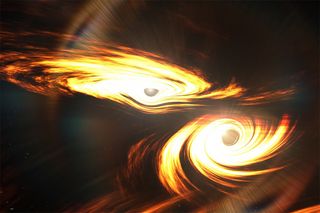Researchers detect 1st merger between black holes with eccentric orbits

Scientists have for the first time confirmed the merger of two highly eccentric black holes.
Egg-shaped eccentric orbits form when two black holes spiral towards each other and collide under each other's strong gravitational influence. Therefore, highly eccentric orbits may suggest black holes repeatedly snack on other black holes in densely populated areas, like the center of a galaxy. When black holes merge, they send out gravitational waves, which differ based on the shape of the black holes' orbit, circular versus oval.
Researchers from the Rochester Institute of Technology (RIT) and the University of Florida studied GW190521 — the most massive gravitational wave signal observed from a binary black hole system — to determine if the two black holes had eccentric orbits before they merged.
Related: The 10 wildest things we learned about black holes in 2021
"The estimated masses of the black holes are more than 70 times the size of our sun each, placing them well above the estimated maximum mass predicted currently by stellar evolution theory," Carlos Lousto, a professor at RIT and co-author on the new research, said in a statement. "This makes an interesting case to study as a second generation binary black hole system and opens up to new possibilities of formation scenarios of black holes in dense star clusters."
Using hundreds of computer simulations, the researchers found that the gravitational wave signals from GW150521 are best explained by a high-eccentricity, according to the statement.
The study also sheds new light on how some of the black hole mergers detected by the Laser Interferometer Gravitational-wave Observatory (LIGO) and its European counterpart, Virgo, are so much heavier than previously thought possible. Their findings were published Jan. 20 in the journal Nature Astronomy.
Get the Space.com Newsletter
Breaking space news, the latest updates on rocket launches, skywatching events and more!
"This represents a major advancement in our understanding of how black holes merge," Manuela Campanelli, another RIT professor and co-author, said in the statement. "Through our sophisticated supercomputer simulations and the wealth of new data provided by LIGO and Virgo's rapidly advancing detectors, we are making new discoveries about the universe at astonishing rates."
The researchers also used the gravitational-wave observations from GW150521 and its possible electromagnetic counterpart observed by the Zwicky Transient Facility to measure the Hubble constant — a unit of measurement used to describe the expansion of the universe. Their models suggest that black hole mergers exhibit some amount of eccentricity. This work was the focus of another study published last year in the Astrophysical Journal Letters by the same team.
Follow Samantha Mathewson @Sam_Ashley13. Follow us on Twitter @Spacedotcom and on Facebook.
Join our Space Forums to keep talking space on the latest missions, night sky and more! And if you have a news tip, correction or comment, let us know at: community@space.com.

Samantha Mathewson joined Space.com as an intern in the summer of 2016. She received a B.A. in Journalism and Environmental Science at the University of New Haven, in Connecticut. Previously, her work has been published in Nature World News. When not writing or reading about science, Samantha enjoys traveling to new places and taking photos! You can follow her on Twitter @Sam_Ashley13.
